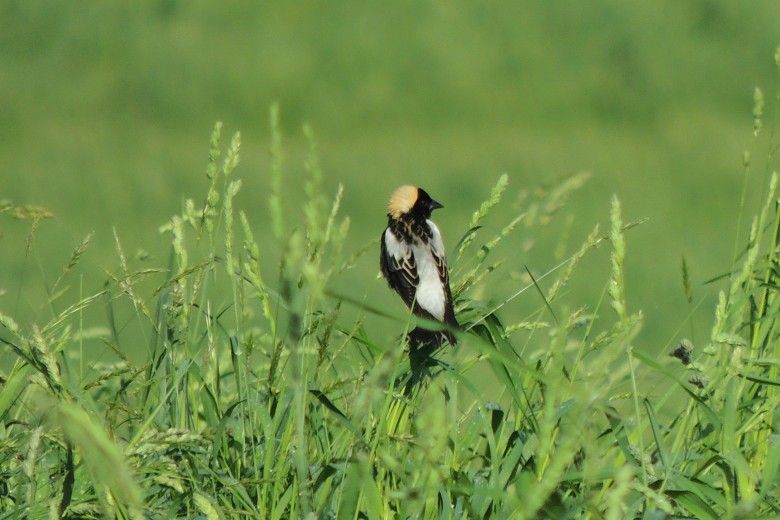Delay the Haying to Help Bobolinks Thrive

How would you feel about a visitor who arrives without warning, then decides to camp behind your house for a few weeks, singing loudly and raising a family? And oh yes, he’s brought a dozen friends?
You might feel differently if your visitors are Bobolinks. These brilliantly colored songbirds fly an incredible 12,000 miles north in spring, from the pampas of South America, just to nest in hayfields and meadows in our region.
Starr Cummin Bright was thrilled to discover her Bobolink visitors in the first week of May, 15 years after she had last hosted them. “I was astonished and truly delighted to see eight males one day and more than a dozen the next, flying between the tall grass and the tops of trees bordering our field. The males are quite ostentatious, with their yellow/buff cap and the white on their backs when they fly. I love how they can perch on the top of grass stems or the very tops of trees without the slender stalks/ twigs bending with their weight.”
Starr and her husband J. Clayton Bright have a farm in the King Ranch area of Chester County that has been preserved by a Brandywine Conservancy conservation easement. The area has thousands of acres of contiguous preserved land, much of it planted in fields of forage and hay, which is excellent Bobolink breeding habitat. Bobolinks prefer tall lush grasses. Hayfields, pastures and unmowed meadows are all good habitat.
In breeding season Bobolink males sport a yellow crest that contrasts with their black and white bodies; females are brown and blend in with the grass. The males also have a unique song, which to some ears sounds like electronic feedback, not at all bird-like.
Unfortunately, the Bobolink population is at risk due to habitat loss. Their North American population declined 65% between 1966 and 2015. In Pennsylvania the bird’s population is stable but dependent on continued available habitat.
A pair of Bobolinks needs a minimum of 5-10 acres of habitat to nest. But a larger contiguous area attracts a higher density of nesting pairs. It is not uncommon to observe a half dozen or more males chasing each other around a hayfield. When you spot them whipping around the fields on each other’s tail, it is easy to understand why a group of Bobolinks is called a “chain”!
Bobolinks often return to the same location, if they have had successful nests the previous year. However, even with suitable habitat, the presence of Bobolinks in a particular location is not a given.
A critical factor in nest success is lack of disturbance to the field. The female builds her nest directly on the ground, hidden by the tall grass. After an incubation period of 10-14 days, the eggs hatch; the chicks mature after another 10 days. Then the Bobolink may have a second brood. If the Bobolinks have nested in a hayfield, any mowing during that time will destroy the nests and can kill the incubating female.
If you have Bobolinks nesting in your hayfield, delaying the first cutting until the birds have completed their nesting is the best way to protect them. That typically means delaying the mowing by six weeks. That is what Starr decided to do. “Aside from haying late, I will keep an eye on my dogs and keep them out of the tall grass (it' s not that hard - they don't really like pushing through and getting seeds in their eyes). Even I don't enjoy walking/slogging through waist high grass.”
Bobolinks put in an amazing journey to partake of our region’s hospitality for a few weeks before moving to coastal marshes and wetlands where they molt and prepare to make that 12,000 mile trip back to the Southern Hemisphere. While they’re here they put on a show. Look for them in fields and meadows as you drive along country roads and thank a farmer for making their visit a success.
“Some keep the Sabbath going to Church –
I keep it, staying at Home –
With a Bobolink for a Chorister –
And an Orchard, for a Dome –
Some keep the Sabbath in Surplice –
I, just wear my Wings –
And instead of tolling the Bell, for Church,
Our little Sexton – sings.
God preaches, a noted Clergyman –
And the sermon is never long,
So instead of getting to Heaven, at last –
I’m going, all along.”
–Emily Dickinson
Header image credit: Bobolink on land protected by the Brandywine Conservancy by John Goodall